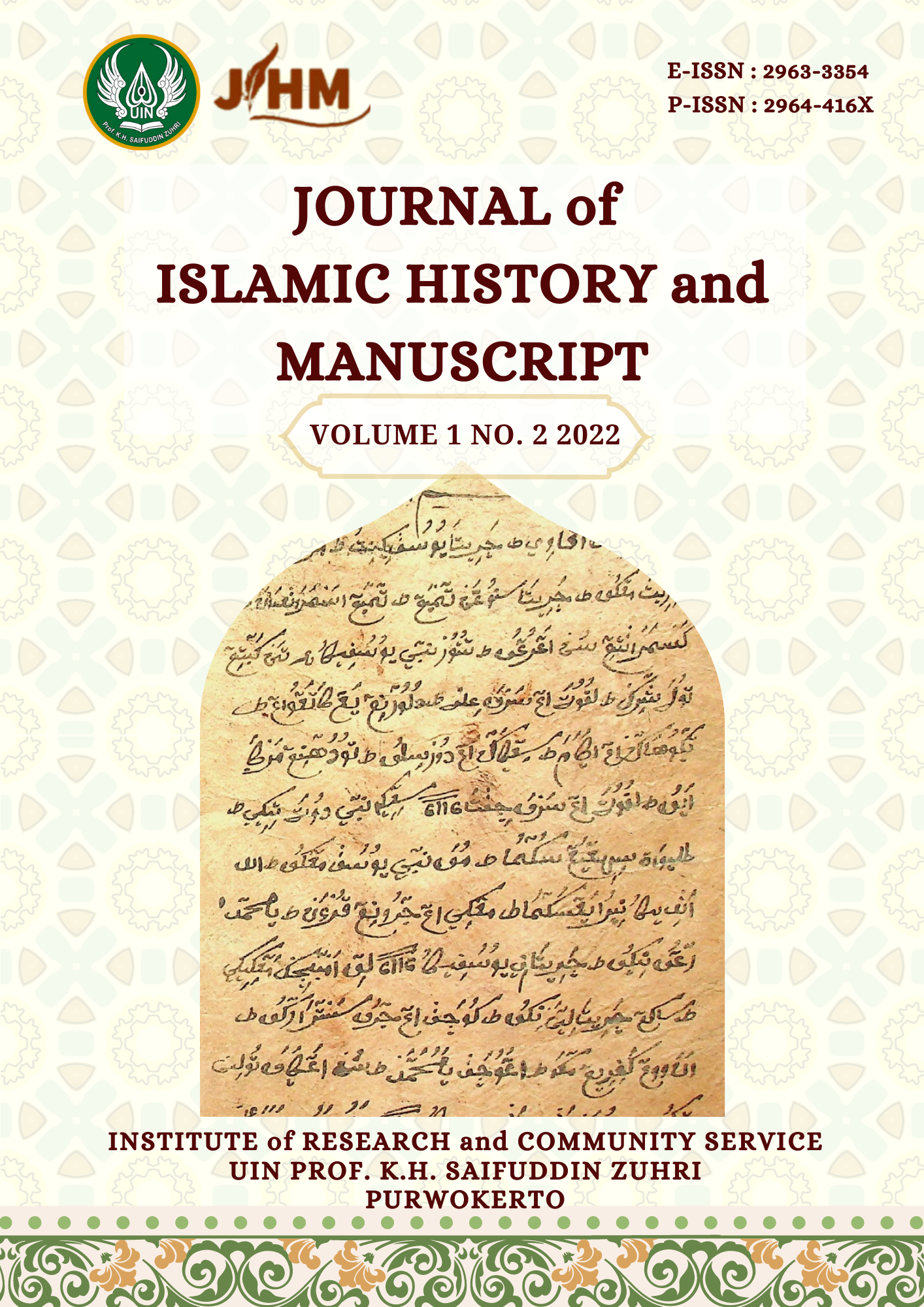Tujuh and Sembilan Sacred Tombs Sites in Ketapang, West Kalimantan: Historical-Archaeological Studies and Receptions
DOI:
https://doi.org/10.24090/jihm.v1i2.6960Keywords:
Archaeological Sacred Tomb, Ketapang, West KalimantanAbstract
This study aims to expose the history of Islam in Ketapang by referring to Tujuh and Sembilan sacred tombs and narrating the reception (in the living al-Quran) of the community on the grave and its elements (part of the Quranic text, motifs, and others). This research is field research, using a narrative-analytic model, as well as using a historical approach and the living Quran theory (on reception). The results of this study are: 1) The history of Tujuh and Sembilan sacred tombs are the tombs of pious people who spread Islam in Ketapang around the 14th century A.D. Second, the typology of people's reception in the sentence kullu nafsin dzaiqatul maut is represented in three forms of reception, namely, hermeneutical or exegesis reception, aesthetic reception, and functional reception.References
Abdul Hakim. (2021). The Development Of Islamic Calligraphy And Its Urgency For The Qur’anic Manuscripts. Jurnal Lektur Keagamaan, 19(1), 69–102. Https://Doi.Org/10.31291/Jlk.V19i1.911
Agam Akbar P. (2018). Resepsi Estetik Pada Lukisan Sakban Yadi. Tarbiyatuna, 9(1), 1–17.
Amin, M. (2020). Resepsi Masyarakat Terhadap Al-Quran ( Pengantar Menuju Metode Living Quran ). Ilmu Agama : Mengkaji Doktrin,Pemikiran, Dan Fenomena Agama, 21(2), 290–303.
Andak. (N.D.). Wawancara Tentang Makam Keramat Tujuh Dan Keramat Sembilan.
Andry Dkk. (2021). Keraton-Keramat Mendedah Fakta Mengeja Tanda Mereguh. Iain Pontianak Press.
Anne K.Rasmussen. (2001). The Qur’an In Indonesia Daily Life: The Public Project Of Musixal Oratory’ Dalalm Etnomusicology. Etnomusicology, 45(1), 30–57.
Ashari, M. (2016). Studi Bentuk, Fungsi Dan Makna Ornamen Makam Di Kompleks Makam Raja-Raja Bugis. Dewa Ruci: Jurnal Pengkajian Dan Penciptaan Seni, 8(3), 444–460. Https://Doi.Org/10.33153/Dewaruci.V8i3.1135
Bambang Sakti W.A. (2013). Makam-Makam Dan Candi Di Negeri Baru Dalam Perkembangan Budaya Di Kabupaten Ketapang. Nadit, 7(2), 107–115.
Didin Sirojuddin. (1993). Khat Naskhi Untuk Kebutuhan Primer Baca Tulis.
Farida, U. (2016). Living Qur’an Dalam Studi Qur’an Di Indonesia (Kajian Atas Pemikiran Ahmad Rafiq). Hermeneutik: Jurnal Ilmu Al Qur’an Dan Tafsir, 10 No 2, 17.
Fuady, A. R. (2021). Resepsi Al Qur’an Pada Prosesi Pernikahan Adat Jawa Di Desa Astana Kecamatan Gunung Jati Cirebon. Iain Syekh Nurjati Cirebon.
Hamka. (1989). Tafsir Al Azhar. Pustaka Nasional Pte Ltd.
Jannah, I. L. (2017). Resepsi Estetik Terhadap Alquran Pada Lukisan Kaligrafi Syaiful Adnan. Nun, 3(1), 25–59.
Jinan, M. (2010). Kaligrafi Sebagai Resepsi. Suhuf, 22(2), 142–156.
Laaily Fitriani. (2014). Seni Kaligrafi: Peran Dan Kontribusinya Terhadap Peradaban Islam. Al-Harakah, 5(1).
M.Quraish Shihab. (2002). Tafsir Al Misbah : Pesan, Kesan Dan Keserasian Al-Qur’an. Lentera Hati.
Masrurin, A. (2018). Resepsi Al Qur’an Dalam Tradisi Pesantren Indonesia (Studi Kajian Nadgham Di Pondok Pesantren Tarbiyatul Qur’an Ngadiluweh Kediri). Al-Bayan : Jurnal Studi Al Qur’an Dan Tafsir, Ii(Desember), 101–118.
Mattson, I. (2013). Ulumul Qur’an Zaman Kita: Pengatar Untuk Memahami Konteks, Kisah Dan Sejarah Al-Qur’an, Terj. R. Cecep Lukman Yasin. Zaman.
Muhammad Husein Al Dzahabi. (2005). Al Tafsir Wa Al Mufasirun. Dar Al Hadist.
Oetomo, R. W. (2019). Motif Hias Pohon Hayat Pada Nisan-Nisan Di Barus. Berkala Arkeologi Sangkhakala, 21(2), 151. Https://Doi.Org/10.24832/Bas.V21i2.365
Ramdhan, M. (2021). Metode Penelitian. Cipta Media Nusantara.
Rispul. (2012). Kaligrafi Arab Sebagai Karya Seni. Tsaqafa, Jurnal Kajian Seni Budaya Islam Vol., 1(1), 9–18. Http://Eprints.Uad.Ac.Id/1486/3/02-Tsaqafa-Rispul-Kaligrafi-Arab-Sebagai-Seni.Pdf
Rohman, M. A. (2017). Resepsi Kyai Terhadap Al-Qur’an: Kajian Kitab Tafsir K.H Ahmad Yasin Asymuni. Iain Kediri.
Rudi. (2021). Wawancara Seputar Makam Keramat Tujuh Dan Makam Keramat Sembilan.
Tjandrasasmita, U. (2009). Kutipan Ayat-Ayat Al-Qur ’an Dan Kalimat Sufistik Pada Beberapa Batu Nisan Makam Kuno Di Indonesia. Suhuf, 2(2), 249–270.
Uti Gusti Carma. (2021). Wawancara Tentang Makam Keramat Tujuh Dan Keramat Sembilan.
Uti Syahruddin. (2021). Wawancara Seputar Makam Keramat Tujuh Dan Sembilan.
Widarto, Pardjono, & Widodo, N. (2012). Pengembangan Model Pembelajaran Kaligrafi Berbasis Kaidah Imlaiyyah. Cakrawala Pendidikan, 8(3), 409–423.
Zakaria. (2021). Wawancara Seputar Makam Keramat Tujuh Dan Sembilan.
Downloads
Published
How to Cite
Issue
Section
License
Copyright (c) 2022 Maryani, Wendi Parwanto

This work is licensed under a Creative Commons Attribution 4.0 International License.
Authors who publish in this journal agree to the following terms:
- Authors retain copyright and grant the journal right of first publication with the work simultaneously licensed under a Creative Commons Attribution 4.0 International License. that allows others to share the work with an acknowledgment of the work's authorship and initial publication in this journal.
- Authors can enter into separate, additional contractual arrangements for the non-exclusive distribution of the journal's published version of the work (e.g., post it to an institutional repository or publish it in a book), with an acknowledgment of its initial publication in this journal.
- Authors are permitted and encouraged to post their work online (e.g., in institutional repositories or on their website) before and during the submission process, as it can lead to productive exchanges and earlier and greater citation of published work (See The Effect of Open Access).

















